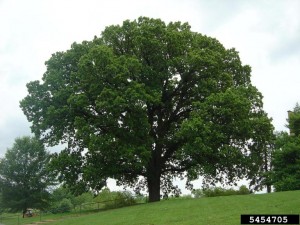Muskrat Day. Velcro Appreciation Month. Hair Follicle Hygiene Week. Arbor Day. You know it’s an obscure event when the greeting-card trade hasn’t bothered to capitalize on it. I like to think the industry knows Arbor Day is worthy of a Hallmark line, but that they’ve decided to honor its spirit by conserving paper. (C’mon, it’s possible.)
While it’s not the best-known observance, Arbor Day has a respectable history, as well as local, um, roots. Begun in 1872 by Adams, NY native J. Sterling Morton, Arbor Day was intended to highlight the need to conserve topsoil and increase timber availability in his adopted state of Nebraska. Though it began as an American tradition, Arbor Day, which is observed on the last Friday in April, is now celebrated worldwide.
Not only was Morton passionate about planting trees, for him the act seemed to verge on the sacred. He said “The cultivation of trees is the cultivation of the good, the beautiful and the ennobling in mankind,” and believed every tree planted made this nation a little better. J. Sterling went on to become rich and famous with his Morton Salt Company, and Arbor Day went on to become a somewhat obscure, if virtuous, tradition.
I tend to agree with Morton’s lofty pronouncement. To plant a tree is to invest in the future, and is an act of generosity and responsibility. When we add a tree to our community, it’s likely that many generations of people after our passing will enjoy it.
Trees add value to our lives in surprising ways. Many of us have heard the spiel about how trees decrease home energy costs, increase property value, filter pollutants and all that. But did you know that shoppers spend more money when there are trees in a downtown shopping district, and that homes sell faster on tree-lined streets?
How many of us are aware that hospital patients who can look out on trees from their bed have better outcomes? And did you know that crime rates drop significantly when urban neighborhoods are planted with trees? And that lying under a shade tree in summer cures acne? OK, I made that last one up, but the rest is true.
It may be noble to plant a tree, but it has to be done right or you might as well rent it. A poorly planted tree will only live a fraction of its potential lifespan. Location is the first thing to consider. Kids and trees generally look cute when you bring them home from the nursery, but they grow up fast and often take up more room than you expected. If your site is under wires or has restricted space for branches or roots you need the right species and variety of tree that can grow full-size without causing conflicts.
The old adage “dig a fifty-dollar hole for a five-dollar tree” may need to be adjusted for inflation but the idea still has currency, so to speak. Ninety percent of tree roots are in the top ten inches of soil. To reflect this fact, the planting hole should be saucer-shaped and 2-3 times the diameter of the root system, but no deeper—ever. Otherwise the Planting Police will ticket you. OK that’s fiction too, but if I happen to come along I may scowl at you. It’s imperative the root flare (a.k.a. trunk flare) be right at ground level, because deep planting leads to serious future health problems. For the tree, primarily.
Before backfilling, remove all fabric and twine on ball-and-burlap trees, and yes, those wire cages should be cut away. Container-grown trees may have circling roots that need to be teased out straight.
Adding loads of organic matter to the backfill likely dates back to ancient times, when folks might grab an arborist, if one was handy, and throw them in the planting hole. Possibly in response to this, arborists these days recommend little or no additional organic matter in most cases.
With very sandy or heavy clay soils, moderate amounts of peat moss, compost or other amendments can be used in the backfill. Adding more than 30% by volume can cause a “teacup effect,” and roots can suffocate (water is held in the hole and doesn’t move into the soil quickly). Fertilizer is stressful on new transplants, so wait at least a year on that. In healthy native soils, trees may need little or no fertilizer.
Water thoroughly as you backfill, and prod the soil with a stick or shovel handle to eliminate air pockets. Unless the site is very windy it’s best not to stake the tree—movement is needed for a strong trunk to develop.
Two to four inches of mulch over the planting area (but not touching the trunk) will help conserve moisture and suppress weeds. Throughout the first season, check the soil every few days to be sure it’s moist but not waterlogged.
If you’re looking for a suggestion, here are some exceptional trees for street and yard planting:
- Washington Hawthorn – small, disease resistant, white flowers, tolerates road salt
- Japanese Tree Lilac – small, drought tolerant, large cream-colored flowers
- Heritage River Birch – med-large, few insect pests, pinkish-white peeling bark
- Skyline Honeylocust – med-large, tolerant of wet soils, drought & road salt, thornless
- Prairie Pride Hackberry – large, drought tolerant, wildlife eat berries
- Kentucky Coffeetree – large, disease and pest free, drought tolerant
- Bur Oak – large, tolerant of both drought and intermittently wet soil, and can live 800+ years
Have a happy Arbor Day on April 24th – or any day. Planting a tree is a great activity to share with loved ones, and a great investment in the future.
Article courtesy of Paul Hetzler, Cornell Cooperative Extension of St. Lawrence County

Photo by Jason Sharman, Vitalitree, Bugwood.org